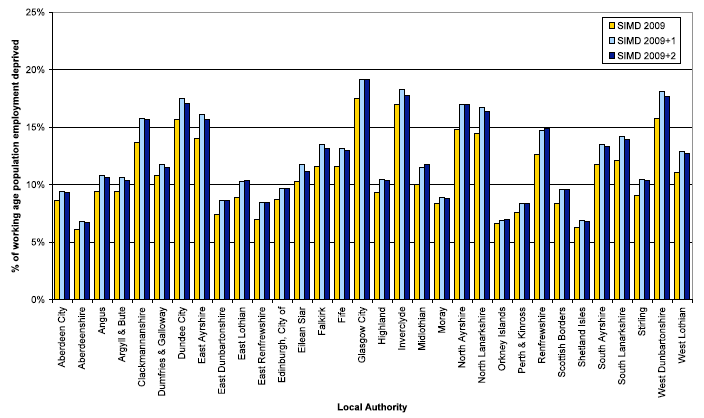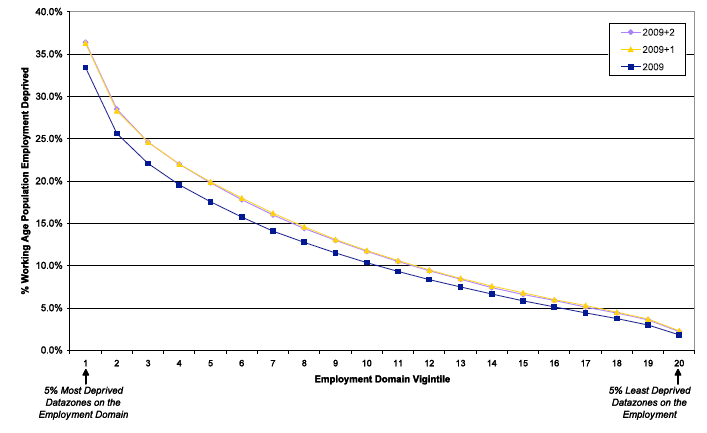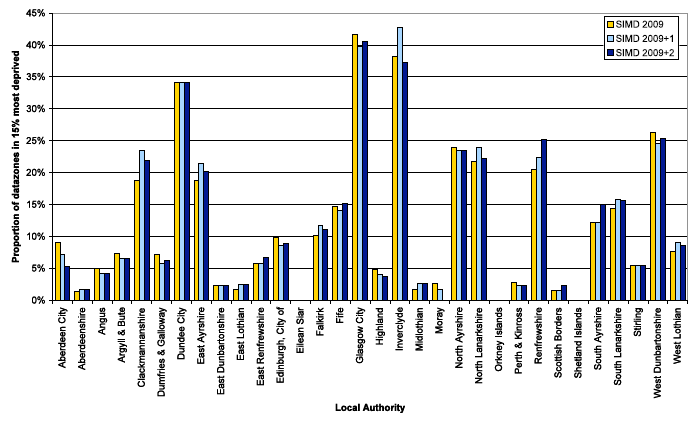Updates to SIMD Income and Employment Domains
Updates to SIMD Income and Employment Domains
Employment Domain
17. Being out of work is acknowledged as being a key factor of deprivation. The employment domain of the Scottish Index of Multiple Deprivation ( SIMD) identifies the proportion of people from the resident working age population who are unemployed or who are not involved in the labour market due to ill-health or disability.
18. The different versions of the employment domain are shown in the table below.
| Version | Period benefits data relates to # | Period population data relates to |
|---|---|---|
| SIMD 2004 | January 2002 - December 2002 | April 2001 |
| SIMD 2006 | January 2005 - December 2005 | Mid 2004 |
| SIMD 2009 | January 2008 - December 2008 | Mid 2007 |
| SIMD 2009+1 | January 2009 - December 2009 | Mid 2008 |
| SIMD 2009+2 | January 2010 - December 2010 | Mid 2009 |
# Note that the periods between versions of the domain are not of equal length.
19. The indicators used in the employment domain have remained largely the same over the three versions of the SIMD and the two additional updates so it is possible to assess change in terms of both the datazone ranks and in terms of the numbers and distribution of employment deprived people. The indicators used are listed in Annex A and the SIMD 2009 Technical Report2 provides further information.
20. The age at which women reach State Pension age is gradually increasing from 60 to 65 between April 2010 and April 2020. The number of women eligible to receive working age benefits will therefore have risen slightly since last year. The rates used in the SIMD 2009+2 employment domain continue to use the working age population of 16-59 for women and 16-64 for men as the denominator. As a result the employment domain counts and rates may have risen slightly since last year. The impact of this change is likely to be very small with only a few additional 60 year old women now being included. We will review this approach for subsequent updates to ensure the best comparability over time possible.
Number and percentage of employment deprived
21. SIMD 2009 used 2008 benefit data and so did not reflect the impact of the economic downturn. SIMD 2009+1 used more recent data and so provided some indication of the impact of the downturn. SIMD 2009+2 uses data covering 2010 and so may begin to show the effects of the recovery.
22. The employment domain in SIMD 2009+2 is very highly correlated with both the SIMD 2009 and the SIMD 2009+1 employment domain with Pearson's correlation coefficients of 0.98 And 0.99 respectively.
23. The figures quoted below can be found in charts 1 and 2 in this document and in table 1, found here: www.Scotland.gov.uk/Topics/Statistics/SIMD/AnnualUpdates.
Chart 1: Percentage of working age population employment deprived by local authority, SIMD 2009, SIMD 2009+1 and SIMD 2009+2

24. The overall level of employment deprivation has fallen slightly since the first annual update from 13.1% of the working age population in SIMD 2009+1 to 12.9% in SIMD 2009+2. However this remains above the level observed in SIMD 2009 (11.6%).
25. Most local authorities (21) have seen a small decrease in the percentage of employment deprived people since the last update with a further 7 having experienced no change. Only Midlothian (0.3 percentage points), Renfrewshire (0.2 percentage points), Orkney and East Lothian (both 0.1 percentage points) have experienced small increases. However, in every local authority the percentage remains higher than in SIMD 2009.
26. Since SIMD 2009 Renfrewshire has seen the largest increase in the percentage of working age people who are employment deprived - a rise of 2.3 percentage points (from 12.6% to 14.9%). Moray and Orkney Islands, on the other hand, have seen the smallest increase, rises of 0.4 percentage points.
27. The biggest reductions since SIMD 2009+1 have been in Eilean Siar (a fall of 0.6 percentage points from 11.8% to 11.2%) and Inverclyde (0.5 percentage points from 18.3% to 17.8%).
28. Glasgow City continues to have a higher proportion of its working age population experiencing employment deprivation than any other local authority at 19.2% (the same as in SIMD 2009+1 and an increase from 17.5% in SIMD 2009).
29. Other local authorities with high percentages include Inverclyde (17.8%), West Dunbartonshire (17.7%) and Dundee City (17.1%) although these have all seen reductions since SIMD 2009+1.
30. In contrast, just 6.7% of the working age population in Aberdeenshire and 6.8% in the Shetland Islands are employment deprived.
Chart 2: Percentage of working age population employment deprived by employment domain vigintile, SIMD 2009, SIMD 2009+1 and SIMD 2009+2

31. Chart 2 shows that the most employment deprived areas worsened by more than the less employment deprived areas between SIMD 2009 and SIMD 2009+1. Between SIMD 2009+1 and SIMD 2009+2 there has been very little change.
The 15% most employment deprived
32. Around 91% of the datazones in the 15% most deprived in the SIMD 2009+2 employment domain were also in the 15% most deprived in SIMD 2009+1. Eighty four per cent were also in the 15% most deprived in both SIMD 2009+1 and SIMD 2009.
33. The figures quoted below can be found in chart 3 in this document and in table 2, found here: www.Scotland.gov.uk/Topics/Statistics/SIMD/AnnualUpdates.
Chart 3: Local share of 15% most employment deprived datazones by local authority, SIMD 2009, SIMD 2009+1 and SIMD 2009+2

34. Between SIMD 2009 and SIMD 2009+1 Inverclyde's local share of datazones in the 15% most employment deprived increased from 38% (42 datazones) to 43% (47 datazones) with the result that Inverclyde replaced Glasgow as the local authority with the highest share of its datazones in the 15% most employment deprived. However, in SIMD 2009+2 this has reversed with Inverclyde's local share having fallen again to 37% (41 datazones) and Glasgow's local share having increased slightly from 40% (276 datazones) to 41% (282 datazones).
35. After a decrease between SIMD 2004 and SIMD 2006, Renfrewshire's local share of the employment domain has risen consistently between SIMD 2006 and this latest update. In SIMD 2006 18% (39) of Renfrewshire's datazones were in the 15% most employment deprived. This has risen to 21% (44 datazones) in SIMD 2009, 22% (48 datazones) in SIMD 2009+1 and 25% (54 datazones) in SIMD 2009+2.
36. Meanwhile Aberdeen City has seen its local share decrease with each update of the employment domain from SIMD 2006 onwards. It has fallen from 10% (27 datazones) in SIMD 2006 to 9% (24 datazones) in SIMD 2009, to 7% (19 datazones) in SIMD 2009+1 and to 5% (14 datazones) in SIMD 2009+2.
There is a problem
Thanks for your feedback